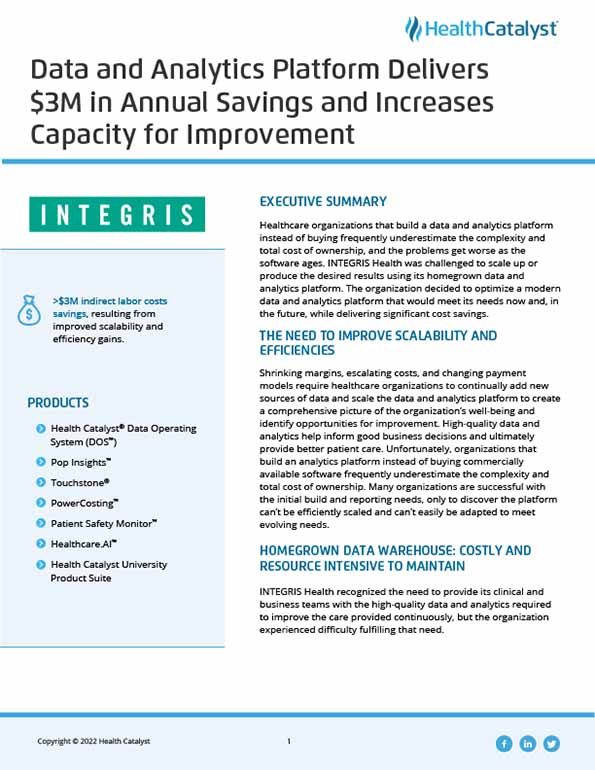Healthcare organizations that build a data and analytics platform instead of buying frequently underestimate the complexity and total cost of ownership, and the problems get worse as the software ages. INTEGRIS Health was challenged to scale up or produce the desired results using its homegrown data and analytics platform. The organization decided to optimize a modern data and analytics platform that would meet its needs now and, in the future, while delivering significant cost savings.
Shrinking margins, escalating costs, and changing payment models require healthcare organizations to continually add new sources of data and scale the data and analytics platform to create a comprehensive picture of the organization’s well-being and identify opportunities for improvement. High-quality data and analytics help inform good business decisions and ultimately provide better patient care. Unfortunately, organizations that build an analytics platform instead of buying commercially available software frequently underestimate the complexity and total cost of ownership. Many organizations are successful with the initial build and reporting needs, only to discover the platform can’t be efficiently scaled and can’t easily be adapted to meet evolving needs.
INTEGRIS Health recognized the need to provide its clinical and business teams with the high-quality data and analytics required to improve the care provided continuously, but the organization experienced difficulty fulfilling that need.
It had developed an internal data warehouse and spent substantial resources building, updating, and maintaining the warehouse; however, operating costs were too high. The organization spent years attempting to provide the data, analytics, and insights its leadership and teams desired but were unable to do so. Data weren’t transparent, and leaders couldn’t get the level of data they needed, nor did they trust the data presented to them. Cohort definitions were unclear and incorrect and could not be replicated across various reports, further eroding trust in the data, and driving up inefficiencies associated with not having reusable data.
The organization needed a more efficient, scalable data and analytics platform that would provide high-quality data and analytics to provide its leaders with the insights required to improve continuously.
INTEGRIS Health implemented the Health Catalyst® Data Operating System (DOS™) platform and a robust suite of analytics applications, including Health Catalyst Pop Insights™, Touchstone®, PowerCosting™, Patient Safety Monitor™, and Healthcare.AI™, to meet the organization’s needs for high-quality data and analytics.
The organization ceased internal efforts to develop a data and analytics platform, embracing the Health Catalyst data and analytics platform as its source for high-quality data and analytics. It engaged Health Catalyst professional services and utilized Health Catalyst's Tech-Enabled Managed Services (TEMS) analytics management team. The Health Catalyst TEMS analytics team is responsible for developing and delivering the critical data and insights required for continuous improvement. Data from seven disparate data sources are integrated into the data and analytics platform—a secure, scalable, stable platform—and application data are reusable.
Data are transparent and are validated by subject matter experts and operations leaders. High-value data and analytics enable insights that are credible and trusted. INTEGRIS Health uses Pop Insights to visualize key performance indicators quickly, easily, and confidently. The organization’s strategic priorities are organized in pillars aligned with the overall strategy. It leverages the data and analytics platform to provide pillar owners and leaders with data and visualizations for each key performance indicator (KPI).
In addition to leveraging the data and analytics platform and applications from Health Catalyst, INTEGRIS Health made organizational changes to streamline workflows around analytics tasks. The organization transferred responsibility for analytics and the analytics team to the vice president of continuous improvement. This aligns the two critical functions, creating seamless support for strategic priorities, and deploying solutions and workflow changes to support strategic changes and the INTEGRIS Health leadership team. INTEGRIS Health collapsed the layers between data scientists, analytics engineers, subject matter experts, and operations leaders, implementing an iterative process where analytics team members work directly with subject matter experts, key stakeholders, and operations leaders, using analytics to answer strategic business questions.
Analytics engineers are partnered with a KPI business owner. They have full accountability to understand, document, and produce KPIs using the analytics platform and visualized in Pop Insights. KPIs are displayed consistently across the organization and utilized as a part of monthly business reviews where KPI owners report performance, including trended graphs with integrated AI techniques and improvement plans. KPI owners first report performance for incented metrics, which are developed systemwide using Touchstone and Healthcare.AI. INTEGRIS Health uses educational offerings from Health Catalyst University Product Suite to complement its internal education offerings, helping learners increase their problem-solving skills and ability to use data and analytics to answer critical questions.
"With the Health Catalyst data and analytics platform, we’re able to capitalize on having disparate data in a curated, well-documented, stable location and data ecosystem—requiring 50 percent fewer people to maintain than when we were building our own platform."
- Lisa Olenski, MBA, Vice President, Continuous Improvement, INTEGRIS Health
For the first time, INTEGRIS Health has a scalable data and analytics platform that can deliver the high-quality data and analytics required to understand and continually improve organizational performance.
Leaders now have the data and insight required to identify opportunities and make data-informed decisions. Team members trust the data and spend their time discussing how to use it for decision-making and improving performance.
Results include:
INTEGRIS Health plans to expand the use of the data and analytics platform and, with its newfound capacity, focus more time on continuous improvement.


